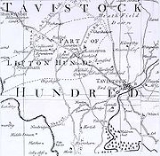
Whitchurch, Devon
Encyclopedia
Whitchurch is a village just to the south-east of the town of Tavistock, Devon
, England. It lies in the West Devon
local authority area, and within Tavistock Deanery
for ecclesiastical purposes. Due to the expansion of Tavistock in recent years, the two settlements have joined and Whitchurch is now considered part of Tavistock, but historically, Whitchurch formed part of the Roborough Hundred.
It is believed that a church must have been present in Whitchurch as early as the 11th century, and that it was most likely built from the white elvan
that can be found at Roborough Down
only a few miles away. This may be the derivation of the name of the village ("White-church"), though many other English villages bearing the same name are considered to be thus named simply because their churches were either built of stone, or were whitewashed. The main church currently standing in Whitchurch—St. Andrew—is for the most part a 15th century building made from granite
as well as elvan. Many memorials can be found in the church, including a monument to Francis Pengelly (1722) made by John Weston of Exeter showing a "celestial ballet" on a medallion, and also an early 17th century slate slab to the Mooringes of Moortown.
There are several interesting houses within the parish: Walreddon is an Elizabethan house, altered to some extent in the 18th century, was the home of a younger branch of the Courtenays
in the 18th and early 19th centuries; while the so-called Priory, near the church, is a 19th century granite building incorporating a square 4th century entrance tower from an earlier structure.
Devon
Devon is a large county in southwestern England. The county is sometimes referred to as Devonshire, although the term is rarely used inside the county itself as the county has never been officially "shired", it often indicates a traditional or historical context.The county shares borders with...
, England. It lies in the West Devon
West Devon
West Devon is a local government district and borough in Devon, England. Towns in the district include Chagford, Okehampton, Princetown, and Tavistock, where the council is based....
local authority area, and within Tavistock Deanery
Deanery
A Deanery is an ecclesiastical entity in both the Roman Catholic Church and the Church of England. A deanery is either the jurisdiction or residence of a Dean.- Catholic usage :...
for ecclesiastical purposes. Due to the expansion of Tavistock in recent years, the two settlements have joined and Whitchurch is now considered part of Tavistock, but historically, Whitchurch formed part of the Roborough Hundred.
It is believed that a church must have been present in Whitchurch as early as the 11th century, and that it was most likely built from the white elvan
Elvan
Elvan is a name used in Cornwall and Devon for the native varieties of quartz-porphyry. They are dispersed irregularly in the Upper Devonian series of rocks and some of them make very fine building stones...
that can be found at Roborough Down
Roborough
Roborough is a village in the South Hams of Devon, England. It lies just outside the northern boundary of the city of Plymouth on the main road to Tavistock, and is a popular dormitory village....
only a few miles away. This may be the derivation of the name of the village ("White-church"), though many other English villages bearing the same name are considered to be thus named simply because their churches were either built of stone, or were whitewashed. The main church currently standing in Whitchurch—St. Andrew—is for the most part a 15th century building made from granite
Granite
Granite is a common and widely occurring type of intrusive, felsic, igneous rock. Granite usually has a medium- to coarse-grained texture. Occasionally some individual crystals are larger than the groundmass, in which case the texture is known as porphyritic. A granitic rock with a porphyritic...
as well as elvan. Many memorials can be found in the church, including a monument to Francis Pengelly (1722) made by John Weston of Exeter showing a "celestial ballet" on a medallion, and also an early 17th century slate slab to the Mooringes of Moortown.
| Year | Population |
|---|---|
| 1801 | 478 |
| 1901 | 1508 |
There are several interesting houses within the parish: Walreddon is an Elizabethan house, altered to some extent in the 18th century, was the home of a younger branch of the Courtenays
Earl of Devon
The title of Earl of Devon was created several times in the Peerage of England, and was possessed first by the de Redvers family, and later by the Courtenays...
in the 18th and early 19th centuries; while the so-called Priory, near the church, is a 19th century granite building incorporating a square 4th century entrance tower from an earlier structure.

